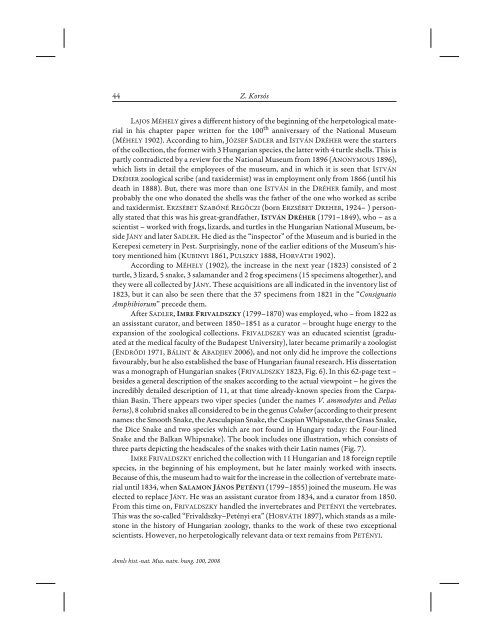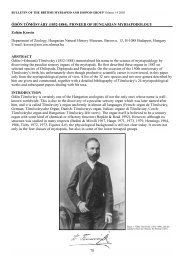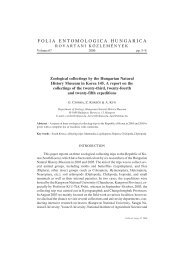History of the Herpetological Collection of the ... - Korsós Zoltán
History of the Herpetological Collection of the ... - Korsós Zoltán
History of the Herpetological Collection of the ... - Korsós Zoltán
You also want an ePaper? Increase the reach of your titles
YUMPU automatically turns print PDFs into web optimized ePapers that Google loves.
44 Z. Korsós<br />
LAJOS MÉHELY gives a different history <strong>of</strong> <strong>the</strong> beginning <strong>of</strong> <strong>the</strong> herpetological material<br />
in his chapter paper written for <strong>the</strong> 100 th anniversary <strong>of</strong> <strong>the</strong> National Museum<br />
(MÉHELY 1902). According to him, JÓZSEF SADLER and ISTVÁN DRÉHER were <strong>the</strong> starters<br />
<strong>of</strong> <strong>the</strong> collection, <strong>the</strong> former with 3 Hungarian species, <strong>the</strong> latter with 4 turtle shells. This is<br />
partly contradicted by a review for <strong>the</strong> National Museum from 1896 (ANONYMOUS 1896),<br />
which lists in detail <strong>the</strong> employees <strong>of</strong> <strong>the</strong> museum, and in which it is seen that ISTVÁN<br />
DRÉHER zoological scribe (and taxidermist) was in employment only from 1866 (until his<br />
death in 1888). But, <strong>the</strong>re was more than one ISTVÁN in <strong>the</strong> DRÉHER family, and most<br />
probably <strong>the</strong> one who donated <strong>the</strong> shells was <strong>the</strong> fa<strong>the</strong>r <strong>of</strong> <strong>the</strong> one who worked as scribe<br />
and taxidermist. ERZSÉBET SZABÓNÉ REGÕCZI (born ERZSÉBET DREHER, 1924– ) personally<br />
stated that this was his great-grandfa<strong>the</strong>r,<br />
(1791–1849), who – as a<br />
scientist – worked with frogs, lizards, and turtles in <strong>the</strong> Hungarian National Museum, beside<br />
JÁNY and later SADLER. He died as <strong>the</strong> “inspector” <strong>of</strong> <strong>the</strong> Museum and is buried in <strong>the</strong><br />
Kerepesi cemetery in Pest. Surprisingly, none <strong>of</strong> <strong>the</strong> earlier editions <strong>of</strong> <strong>the</strong> Museum’s history<br />
mentioned him (KUBINYI 1861, PULSZKY 1888, HORVÁTH 1902).<br />
According to MÉHELY (1902), <strong>the</strong> increase in <strong>the</strong> next year (1823) consisted <strong>of</strong> 2<br />
turtle, 3 lizard, 5 snake, 3 salamander and 2 frog specimens (15 specimens altoge<strong>the</strong>r), and<br />
<strong>the</strong>y were all collected by JÁNY. These acquisitions are all indicated in <strong>the</strong> inventory list <strong>of</strong><br />
1823, but it can also be seen <strong>the</strong>re that <strong>the</strong> 37 specimens from 1821 in <strong>the</strong> “Consignatio<br />
Amphibiorum” precede <strong>the</strong>m.<br />
After SADLER,<br />
(1799–1870) was employed, who – from 1822 as<br />
an assisstant curator, and between 1850–1851 as a curator – brought huge energy to <strong>the</strong><br />
expansion <strong>of</strong> <strong>the</strong> zoological collections. FRIVALDSZKY was an educated scientist (graduated<br />
at <strong>the</strong> medical faculty <strong>of</strong> <strong>the</strong> Budapest University), later became primarily a zoologist<br />
(ENDRÕDI 1971, BÁLINT &ABADJIEV 2006), and not only did he improve <strong>the</strong> collections<br />
favourably, but he also established <strong>the</strong> base <strong>of</strong> Hungarian faunal research. His dissertation<br />
was a monograph <strong>of</strong> Hungarian snakes (FRIVALDSZKY 1823, Fig. 6). In this 62-page text –<br />
besides a general description <strong>of</strong> <strong>the</strong> snakes according to <strong>the</strong> actual viewpoint – he gives <strong>the</strong><br />
incredibly detailed description <strong>of</strong> 11, at that time already-known species from <strong>the</strong> Carpathian<br />
Basin. There appears two viper species (under <strong>the</strong> names V. ammodytes and Pelias<br />
berus), 8 colubrid snakes all considered to be in <strong>the</strong> genus Coluber (according to <strong>the</strong>ir present<br />
names: <strong>the</strong> Smooth Snake, <strong>the</strong> Aesculapian Snake, <strong>the</strong> Caspian Whipsnake, <strong>the</strong> Grass Snake,<br />
<strong>the</strong> Dice Snake and two species which are not found in Hungary today: <strong>the</strong> Four-lined<br />
Snake and <strong>the</strong> Balkan Whipsnake). The book includes one illustration, which consists <strong>of</strong><br />
three parts depicting <strong>the</strong> headscales <strong>of</strong> <strong>the</strong> snakes with <strong>the</strong>ir Latin names (Fig. 7).<br />
IMRE FRIVALDSZKY enriched <strong>the</strong> collection with 11 Hungarian and 18 foreign reptile<br />
species, in <strong>the</strong> beginning <strong>of</strong> his employment, but he later mainly worked with insects.<br />
Because <strong>of</strong> this, <strong>the</strong> museum had to wait for <strong>the</strong> increase in <strong>the</strong> collection <strong>of</strong> vertebrate material<br />
until 1834, when<br />
(1799–1855) joined <strong>the</strong> museum. He was<br />
elected to replace JÁNY. He was an assistant curator from 1834, and a curator from 1850.<br />
From this time on, FRIVALDSZKY handled <strong>the</strong> invertebrates and PETÉNYI <strong>the</strong> vertebrates.<br />
This was <strong>the</strong> so-called “Frivaldszky–Petényi era” (HORVÁTH 1897), which stands as a milestone<br />
in <strong>the</strong> history <strong>of</strong> Hungarian zoology, thanks to <strong>the</strong> work <strong>of</strong> <strong>the</strong>se two exceptional<br />
scientists. However, no herpetologically relevant data or text remains from PETÉNYI.<br />
Annls hist.-nat. Mus. natn. hung. 100, 2008




